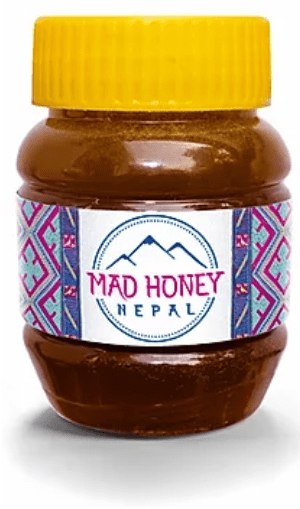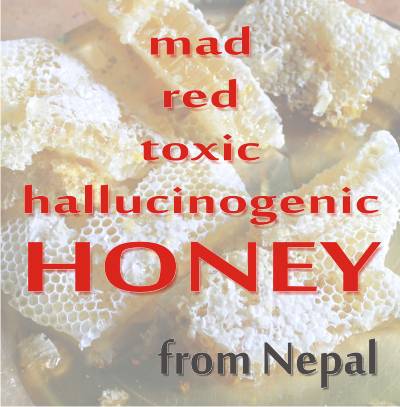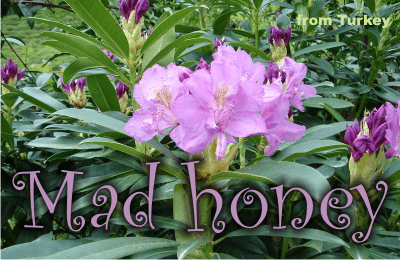Why mad? Both medicinal and recreational sound good; why mad?
Because it can induce a hallucinogenic state, which is associated with madness by some people. And because it can cause “mad honey disease”. Which is not something to play with.
So before moving forward, a word of caution: do not buy or eat mad honey (aka bitter honey) sold by locals, especially from Turkey and Nepal. They know how to take it, its effects, and how to give first aid. You don’t.
If you want to stay safe, buy it from specialized shops, that have done the lab tests needed to ensure its safety. They will never sell mad honey that exceeds safety limits.
Here are some recommendations for mad honey coming from Turkey, and from Nepal.
Can mad honey drive you mad if it is also medicinal honey?
It is called mad because if its main source of nectar comes from rhododendron, then its toxicity can be very high, thus leading to “mad honey disease”, eventually affecting the brain. And, as I said before, mad also comes from a certain hallucinogenic effect it may have on people, altering perception and inducing a surreal feeling of freedom. Hence, its recreational use.
‘‘… but the swarms of bees in the neighborhood were numerous, and the soldiers who ate of the honey all went of their heads, and suffered from vomiting and diarrhea, and not one of them could stand up, but those who had eaten a little were like people exceedingly drunk, while those who had eaten a great deal seemed like crazy, or even, in some cases, dying men. So they lay there in great numbers as though the army had suffered a defeat, and great despondency prevailed. On the next day, however, no one had died, and at approximately the same hour as they had eaten the honey they began to come to their senses; and on the third or fourth day they got up, as if from a drugging’’ as described by the Greek warrior-writer Xenophon in 401 BC, in his Anabasis.
Is mad honey found only in Turkey and Nepal?
No. The plants containing the toxin that gives honey its madness, which is grayanotoxin, do not grow only in these 2 places. There are many plants of the Ericaceae family, Rhododendron, Pieris, Agarista and Kalmia, that contain diterpene grayanotoxins.
The flowers of Rhododendron species are widely spread over countries such as Spain, Portugal, Japan, Brazil, the United States, Nepal, Great Britain.
In all these countries, any multifloral honey, aka meadow honey, can potentially contain tiny amounts of nectar from these plants. But too tiny to matter.
Read more on Rhododendron honey composition and effects (sourced not in Turkey or Nepal)
How toxic is mad honey?
· Raw mad honey sold by locals, with uncontrolled levels of grayanotoxin, may be very toxic! And hallucinogenic.
· Mad honey sold in specialized shops is lab-tested and safe for moderate consumption. This is not toxic.
Consumption of grayanotoxin containing leaves, flowers or secondary products such as honey, may result in intoxication (dizziness, hypotension, and atrial-ventricular block). In humans, intoxication is rarely lethal, in contrast to cattle and pet poisoning cases. We don’t eat flowers or leaves, so we ingest a lower quantity of the toxin.
! Mad honey containing high doses of grayanotoxin may indeed intoxicate people. People from Turkey, or Tibet, who are harvesting and selling mad honey, are more resistant to grayanatoxin intoxication, due to gradual consumption. That is why we advise people not to buy mad honey directly from locals, because what is harmless to them, may be toxic to us.
It is hard to establish a lethal dose for mad honey, because it may vary from person to person, according to their own metabolic system.
According to Gunduz et al, of 70 cases of mad honey-related poisoning, 52% were sinus bradycardia, 18.5% non-specific bradycardia, 11.4% nodal rhythm, 11.4% atrioventricular (AV) block, 1.4%
Wolff-Parkinson-White syndrome (WPW), 1.4% second degree heart block, and 1.4% asystole.
Read more about the toxicity of mad honey, case reports and treatment in the article What is mad honey? Is it dangerous? Where can I find it?
Yılmaz et al. reported in 2006 that the amount of mad honey that causes poisoning ranges between 5 and 30 g. However, the lethal dose of mad honey was not stated explicitly.
Why risk getting intoxicated by mad honey?
First of all for its medicinal properties. Then for its recreational side-effect. And for its sweet-bitter taste.
But to be completely honest, there is no risk with mad honey sold in specialized shops. (not honey bought from the streets of Turkey or Nepal, sold by locals). This mad honey is safe and medicinal.
Some enthusiasts reported a light state of euphoria – Placebo or self-induced, probably, as this honey is surely safe, medicinal, and a lot less hallucinogenic than a raw, locally-sold mad honey.
Despite its toxicity, domestic beekeepers produce mad honey on a routine basis for apitherapy, using honeybee products for various therapeutic purposes and applications. And while the scientific evidence for the medicinal properties of grayanotoxin containing preparations is scarce, in folk medicine their use is highly appreciated.
It’s all in the science of knowing how to use them. Plants contain numerous compounds that are called “medicinal” when used under certain conditions. But the same compounds can become “poisonous” if used otherwise. The dose, the other accompanying drugs/plants, the patient’s background, but mostly the dose, are what makes all the difference.
The toxin found in mad honey is grayanotoxin. Read more about it in Toxic Honey.
Mad honey (Rhododendron honey) medicinal use:
Mad honey is, first of all, medicinal honey and has been used in traditional Chinese, Indian, European and American folk medicines due to its rich bioactivity value.
It has also been consumed by Anatolian people for the treatment of gastric pains, bowel disorders, and hypertension. [Demir H et al, 2011 and Sibel S et al, 2014]
• In Turkey, in traditional medicine, mad honey is used to improve appetite, heighten mental alertness, reduce joint pain, eliminate gastrointestinal system pains, and increase sexual performance. ( Gunduz A, Turedi S, Russell RM, Ayaz FA. Clinical review of grayanotoxin/mad honey poisoning past and present. Clin Toxicol, 2008).
• The field where it is most widely used as a natural support product is to enhance sexual performance (Demircan A, Keles A, Bildik F, Aygencel G, Dogan NO, Gomez HF. Mad honey sex: therapeutic misadventures from an ancient biological weapon. Ann Emerg Med, 2009)
• Mad honey, through its grayanotoxin, possesses analgesic, blood pressure lowering and heart rate lowering effects (Gunduz A, Eraydin I, Turkmen S et al. Analgesic effects of mad honey (grayanotoxin) in mice models of acute pain and painful diabetic neuropathy. Human Exp Toxicol 2014; Türkmen S, Karagöz Ü, Gündüz A, Türedi S, Metehan A, Yildirim M. The dose-dependent effect of grayanotoxin on the cardiovascular system. Turk J Med Sci 2013.)
Mad honey has high antioxidant power
Tezcan, F. in 2011 and Alzahrani, H.A. in 2012 showed that this honey contains thousands of different phenolic compounds that possess antioxidant properties that defend cells against attacks by free radicals.
Why do we need antioxidants?
Normally, the levels of oxidants and antioxidants are well-balanced in a healthy cell. However, this balance can change due to oxidative stress caused by unstable molecules (free radicals), which are the primary source of harmful biopolymers including nucleic acids, proteins, carbohydrates, and polyunsaturated fatty acids. (Badarinath, A.V.; 2010) Antioxidants can effectively protect the cells against such damages, being vitally important for the homeostasis of cells and tissues.
High phenolic content.
Phenolic acids found in honey, are such powerful antioxidants. And the findings of Silici and Karaman and Sascha et al. demonstrated that mad honeys have a strong source of phenolics.
High mineral content.
Silici et al. compared Rhododendron and multi-flower honeys in terms of elemental analysis. The authors stated that Rhododendron honeys exhibited higher concentrations of Cu, Co, Cr, Ni, Se, Zn, Ca, and Mg than the multi-flower honeys.
Mad honey has an anti-cancer effect
Its anti-cancer activity is promoted by its high phenolic compounds? [known to exhibit anti-cancer activity through arresting the cell cycle, stimulating apoptosis, suppressing glucose uptake, eliminating drug resistance, inhibiting angiogenesis, and producing various epigenetic changes (Zhou et al., 2016)].
Among its phenolic compounds, Quercetin was used as a single phenolic compound in our study since it is one of the more abundant polyphenols in Rhododendrons (Qiang et al., 2011; Popescu and Kopp, 2013).
It lowers hypertension
High amounts of grayanotoxin induce arterial hypotension and bradycardia. However, controlled amounts on this toxin (found in mad honey) may be useful to lower blood tension.
It helps in diabetes mellitus
Studies have shown to lower blood glucose and lipid levels in rats with diabetes mellitus.
It has antimicrobial effects
Silici S and colleagues reported in 2010 that mad honey has anti-bacterial, antifungal, antioxidant and antimicrobial effects
Mad honey increases sexual performance
Mad honey’s active ingredients are grayanotoxin, aka andromedotoxin. The name comes from Andros, from Greek, which means man, warrior, manly. Perhaps the name is connected to its sexual property.
In 2016, O Tatli et al., investigated the effect of mad honey on sexual performance (study). The researchers gave rates 80 mg/kg normal honey or mad honey throughout the 30-day study period and measured total testosterone, free testosterone, FSH, LH, estradiol, and progesterone levels from blood sera on day 30.
The results revealed significantly higher levels in the mad honey group compared to the normal honey and control groups. Free testosterone levels were also significantly higher in the mad honey group than in the normal honey and control groups. No statistically significant differences were determined for other hormonal measurements: mean estradiol, progesterone, FSH or LH values (p > 0.05).
Read more about the health benefits of mad honey from Turkey, aka deli bal, and where you can buy it from.
Uses of Rhododendron (the plant) in medicine:
Research on the medicinal use of the Rhododendron species, while still in its early stages, has revealed initial results confirming folk belief, to some extent.
Rhododendrons are used as a traditional remedy for prevention and treatment of diseases associated with heart, dysentery, diarrhea, detoxification, inflammation, fever, constipation, bronchitis and asthma: Nisar M et al., 2013.
Other studies showed antioxidant, antimicrobial, anti-inflammatory, analgesic, immunomodulator, antidiabetic, hepatoprotective and cytotoxic effects of Rhododendron species: Yaylaci et al., 2007; Qiang et al., 2011; Popescu and Kopp, 2013; Demir et al., 2016.
– The flowers are used to make pickle, juice, jam, syrup, honey, squash, etc., and to treat various ailments like diarrhea, headache, inflammation, bacterial and fungal infections. (Vikas Kumar et al., 2019) However, due to limited availability of the flower, researchers and processors in food and pharmaceutical sectors, with few exceptions, did not yet exploit it.
– The leaves possess effective antioxidant activity. Young leaves are used to alleviate headache. Phenolic acids obtained from its leaves and twigs have been reported to have anti-HIV, anti-inflammatory, anti-nociceptive activities.
– The wood of this plant can be used for making khukri handles, packsaddles, gift boxes, gunstocks and posts [Saklani S, 2015].
There are some Rhododendron extracts containing grayanotoxin that are sold online. One example is Nao Yang Hua, made from the Japanese Azalea (Rhododendron molle), which is said to benefit numerous ailments, including rheumatoid arthritis and fungal skin infection. However, there are no studies to support these claims.
Rhododendron from Nepal
Rhododendron is the national flower of Nepal! Approximately 500 species can be seen while trekking in the Himalayas of Tibet (Xizang), Nepal and Bhutan. Many of them bloom from March through early May, so, plan your travel wisely, the view is spectacular!
Rhododendrons range from tall trees boasting large white flowers, purple flowered shrubs, to tiny plants creeping along the ground with large red flowers. Among them: rhododendron arboreum, rhododendron campanulatum, rhododendron campylocarpum, rhododendron falconeri, rhododendron grande, rhododendron forrestii.
But only one of them is the national flower of Nepal: Rhododendron arboreum. An impressive tree species that grows to be approximately 20 meters tall and has brilliant red flowers. Traditionally, it is used for the treatment of blood dysentery, nasal bleeding, asthma, stomachaches, blurry vision, fever, heart problems, diabetes, gout, coughs, piles and liver disorders.
 picture credit Gerd Eichmann
picture credit Gerd Eichmann
Can you imagine the amount of nectar these huge trees produce? Enough to feed their Giant Bee of Himalayas, Apis dorsata, a wild bee that reaches up to 3 cm, that will produce the famous Himalayan Red Honey – aka mad, toxic, hallucinogenic honey from Nepal.
Nepalese Mad honey is not a monofloral type. Its nectar comes mainly from Rhododendrons (Rhododendron anthopogon, R. cinnabarinum and R. ponticum), Bikh (Aconitum spp.), Pangra (Entada scanders), Pieris (Pieris formosa) and Niramasi.
Is intoxication with mad honey from Nepal different from that produced by mad honey from Turkey?
No. All cases indicated that grayanotoxin poisoning caused by the ingestion of mad honey from Nepal is similar to that of mad honey from the Black Sea Region of Turkey.
And there were some cases. In 2017, bradycardia and hypotension were reported after consumption of wild honey: case reports of two patients from Eastern Nepal were presented by Shah B and colleagues in the Journal of Nutrition and Food Sciences. According to this study, some wild honey brought from Himalayan areas like Taplejung, kotang of Eastern Nepal may contain high grayanotoxin levels and lead to vomiting, dizziness, tingling sensations, bradycardia, and hypotension, as in the reported patients.
Rhododendron is traditionally used in Far-West Nepal as a remedy for many diseases and is preferred for its diverse medicinal properties with low side-effect profile.
According to madhoney.net, a big seller of Mad Honey from Nepal, “the dosage is the key. In low doses, consumed in a spoonful of honey, the effects of mad honey are exhilarating, including a relaxing, invigorating euphoria mixed with a sense of calm contentedness. Locals will consume a small amount of honey in the morning with their breakfast and enjoy the happy, uplifting effects throughout their day.”
Mad Honey Nepal sells a safe, lab tested honey, to ensure that it’s safe, effective, and metered to the proper dosage so that we know exactly how much grayanotoxin we are consuming each and every time. On condition that we do not eat half the jar at once, but take the recommended dose of one tablespoon per day. And do not feed our children with it. Or pets.
“Whether you’re looking for a quick morning pick-me-up, or a stronger, more mystical experience, Mad Honey Nepal makes certain you get the proper dosage so that you can enjoy mad honey’s pleasures without risking an unpleasant experience.” – Mad Honey Nepal

* This honey is not a hallucinogenic product. If you want to replace your weed with something else, this won’t do it. Its toxic compound is well measured to be safe, but it still retains its medicinal properties.
Find out more about how this honey is produced and harvested, how dangerous and exotic it is, in the article Himalayan Red Honey – aka mad, toxic, hallucinogenic honey from Nepal.
******************
References:
https://pubmed.ncbi.nlm.nih.gov/24837920/
http://www.elis.sk/download_file.php?product_id=5001&session_id=i6ofj3l70rvkq0rnba6p1jc3k2
https://www.ncbi.nlm.nih.gov/pmc/articles/PMC5968227/
https://link.springer.com/article/10.1186/s40066-019-0251-3
Grayanotoxın-III Detectıon And Antıoxıdant Actıvıty of Mad Honey
https://www.researchgate.net/publication/319553263_Bradycardia_and_Hypotension_after_Consumption_of_Wild_Honey_Case_Reports_of_Two_Patients_from_the_Eastern_Nepal




